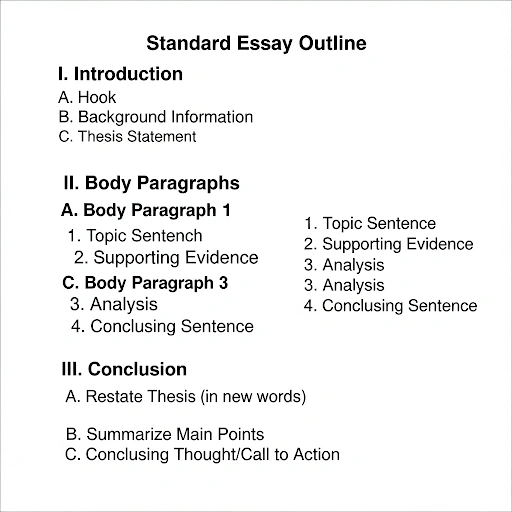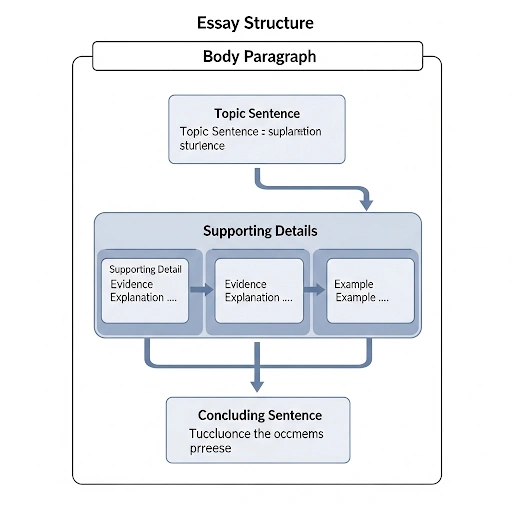The clock is ticking, the deadline is looming, and a blank page stares back at you. We’ve all been there – the high-stakes situation of writing an essay under immense pressure. In these moments, panic can easily derail even the most brilliant ideas. However, what if you could transform that frantic energy into focused productivity? The key lies not in faster typing, but in smarter planning. This guide introduces a time-saving essay method using a quick essay outline, showing how a quick essay outline helps structure your thoughts, and how following a quick essay outline ensures logical flow. By mastering quick essay outline strategies, you can craft a compelling essay efficiently, even when every second counts in 2025.
- What is an Essay Outline, and Why is it Essential Under Pressure?
- Why Learning Quick Essay Outline Strategies Matters
- The “Rapid 5-Paragraph” Essay Outlining Method
- Outlining a Timed Literary Analysis Essay
- Comparison: Outlining Methods for Different Pressures
- Common Mistakes to Avoid When Outlining Under Pressure
- Expert Tips and Best Practices for Rapid Essay Outlining
- FAQ Section
- Conclusion
What is an Essay Outline, and Why is it Essential Under Pressure?
An essay outline is a structured plan or roadmap for your essay, and using a quick essay outline can make this process faster and more efficient. A quick essay outline helps you organize main points, supporting evidence, and arguments in a logical sequence before writing. By following a quick essay outline, you create a clear framework that ensures coherence, while a well-prepared quick essay outline guarantees that all key elements are included. Adopting a quick essay outline approach turns a daunting blank page into a manageable, organized plan.
Why Outlining is Crucial for Essays Under Pressure in 2025:
- Prevents Writer’s Block: When you know exactly what you need to write in each section, the daunting blank page becomes a series of manageable prompts, allowing you to bypass writer’s block.
- Ensures Logical Flow: Under pressure, it’s easy for thoughts to become disorganized. An outline forces you to establish a clear, logical progression of ideas, making your argument easy for the reader to follow.
- Saves Precious Time: While it seems counterintuitive to spend time outlining when time is short, a solid outline drastically reduces time spent rewriting, reorganizing, or getting lost mid-essay. It’s an investment that pays off.
- Guarantees Completeness: A checklist-like outline ensures you include all necessary components (introduction, body paragraphs with evidence, conclusion) and address all parts of the prompt.
- Maintains Focus: With a clear outline, you’re less likely to stray off-topic or include irrelevant information, keeping your essay concise and impactful.
- Boosts Confidence: Seeing your entire essay planned out, even in skeletal form, provides a tremendous psychological boost, helping you feel more in control and less panicked.
For high-pressure situations like timed exams or last-minute assignments, a well-executed quick essay outline method isn’t just helpful—it’s your secret weapon for success. Using a quick essay outline transforms chaos into clarity, allowing you to organize ideas efficiently. A thoughtfully prepared quick essay outline helps you write smarter, not just faster, while a solid quick essay outline ensures that every key point is covered. Adopting a quick essay outline approach makes even the tightest deadlines manageable and keeps your writing focused.

Why Learning Quick Essay Outline Strategies Matters
In today’s fast-paced academic and professional environments, mastering a quick essay outline allows you to rapidly organize your thoughts and present them coherently. Using a quick essay outline method for essays under pressure equips you with practical skills beyond school. A quick essay outline helps streamline your ideas efficiently, while adopting a quick essay outline approach prepares you to tackle real-world writing demands with clarity and confidence.
- Adaptability to Diverse Writing Tasks: From impromptu reports and presentation structures to urgent emails, the ability to quickly outline is transferable across countless scenarios where clear communication is critical.
- Improved Argumentation: A quick outline forces you to identify your core argument (thesis statement) and the most compelling evidence immediately, strengthening your persuasive abilities.
- Enhanced Focus and Efficiency: By front-loading the organizational work, you can dedicate your writing time to crafting sentences and refining language, rather than simultaneously thinking about content and structure.
- Reduced Mental Fatigue: The cognitive load of simultaneously brainstorming, structuring, and writing can be exhausting. An outline separates these tasks, making the process less taxing on your brain.
- Foundation for Longer Works: While focused on essays, the principles of quick outlining scale up to larger projects like research papers, reports, and even presentations, making future academic endeavors smoother.
- Boosts Overall Academic Confidence: Knowing you have a reliable method to tackle timed essays or sudden writing tasks provides a profound sense of calm and competence, benefiting your overall academic performance. For strategies on managing academic demands, consider insights from methodologies such as those in Agile Scrum Certification Tips for Beginners, which emphasize efficiency and iterative planning.
The “Rapid 5-Paragraph” Essay Outlining Method
This time-saving method focuses on the classic 5-paragraph essay structure (Introduction, 3 Body Paragraphs, Conclusion), ideal for timed tests due to its predictability and clarity. Following a quick essay outline helps you organize ideas efficiently, while applying quick essay outline strategies ensures smooth transitions between paragraphs. Adopting a quick essay outline method trains you to plan effectively under pressure, and mastering quick essay outline creation builds confidence to complete essays with ease.
Step 1: Deconstruct the Prompt (2-3 Minutes)
This is the most critical first step. Don’t start writing until you fully understand what’s being asked.
- Identify Keywords: Circle or underline key terms, concepts, and names.
- Identify Command Verbs: What are you being asked to *do*? (e.g., “analyze,” “compare,” “discuss,” “evaluate,” “explain,” “argue”). These dictate your essay’s purpose.
- Identify Limitations/Scope: Are there any specific periods, texts, or perspectives you must address or avoid?
- Brainstorm Initial Ideas: Quickly jot down any immediate thoughts, examples, or arguments that come to mind related to the prompt.
Step 2: Craft Your Thesis Statement (3-5 Minutes)
Your thesis statement is the central argument of your essay. It should be a concise, arguable answer to the prompt.
- Be Direct: State your position clearly and without ambiguity.
- Make it Arguable: It shouldn’t be a simple fact. Someone should be able to disagree with it (and you’ll prove them wrong).
- Include Key Points (Optional but Recommended): For a time-saving outline, your thesis can briefly preview the main points you’ll cover in your body paragraphs. This directly informs your outline.
- Example: Instead of “Dogs are good pets,” try “Dogs make superior pets due to their loyalty, trainability, and emotional support.” (This immediately gives you three body paragraphs!)
Step 3: Develop Body Paragraph Topic Sentences (5-7 Minutes)
Each body paragraph needs a clear topic sentence that directly supports your thesis statement.
- One Idea Per Paragraph: Each topic sentence should introduce the main idea of that specific body paragraph.
- Direct Link to Thesis: Ensure each topic sentence clearly supports or expands upon an aspect of your thesis.
- Use Transition Words: Briefly note transition words or phrases if they come to mind (e.g., “First,” “Furthermore,” “In addition,” “Conversely”).
- List Evidence/Examples: Under each topic sentence, quickly jot down 2-3 pieces of supporting evidence, examples, or specific details you plan to use. These don’t need to be full sentences; just keywords or phrases.

Step 4: Sketch the Introduction & Conclusion (3-5 Minutes)
Briefly outline what each of these sections will contain. Don’t write them fully yet!
- Introduction (Hook, Background, Thesis):
- **Hook:** How will you grab the reader’s attention? (e.g., rhetorical question, surprising fact, brief anecdote).
- **Background:** What context does the reader need to understand your topic?
- **Thesis:** Place your already-crafted thesis statement here.
- Conclusion (Restate Thesis, Summarize, Final Thought):
- **Restate Thesis:** Rephrase your thesis statement in new words.
- **Summarize Main Points:** Briefly recap the topic sentences from your body paragraphs.
- **Final Thought/Implication:** End with a broader statement, a call to action, or a question that leaves the reader thinking.
Step 5: Review and Refine (1-2 Minutes)
A quick check to ensure everything is aligned and logical.
- Thesis-to-Topic Sentence Alignment: Do all your topic sentences clearly support your thesis?
- Logical Flow: Does one paragraph logically lead to the next?
- Sufficiency of Evidence: Do you have enough examples or details for each body paragraph?
- Answered the Prompt?: Does your outline, if followed, fully address all parts of the essay prompt?

Outlining a Timed Literary Analysis Essay
Let’s apply this time-saving essay outlining method for essays under pressure to a common high school scenario: a timed literary analysis essay on a novel like “To Kill a Mockingbird.”
**Prompt:** “Analyze how Harper Lee uses the character of Atticus Finch to explore themes of justice and morality in ‘To Kill a Mockingbird’.” (45 minutes total for outlining and writing).
My Rapid Outline (Approx. 15 minutes):
- Deconstruct Prompt:
- Keywords: Atticus Finch, justice, morality, ‘To Kill a Mockingbird’.
- Command: “Analyze how.”
- Brainstorm: Trial, protecting Boo, teaching Scout/Jem, standing alone.
- Thesis Statement: “Through Atticus Finch’s unwavering commitment to fairness, his embodiment of moral integrity, and his role as a compassionate educator, Harper Lee effectively examines the complex themes of justice and morality in ‘To Kill a Mockingbird’.”
- Body Paragraph Topic Sentences & Evidence:
- **BP1 (Justice – Trial):** Atticus’s defense of Tom Robinson embodies his dedication to legal justice.
- Evidence: Tom Robinson’s trial, Atticus’s closing argument, community reaction.
- **BP2 (Morality – Personal Code):** Beyond legalities, Atticus’s personal moral code highlights the importance of individual conscience.
- Evidence: “It’s a sin to kill a mockingbird,” confronting mob, honesty with children.
- **BP3 (Education/Compassion – Moral Growth):** Atticus acts as a moral compass for his children, illustrating the growth of morality through empathy.
- Evidence: Lessons on “walking in someone else’s skin,” understanding Boo Radley, handling Mrs. Dubose.
- **BP1 (Justice – Trial):** Atticus’s defense of Tom Robinson embodies his dedication to legal justice.
- Intro & Conclusion Sketch:
- **Intro:**
- Hook: Classic American literature, timeless themes.
- Background: Set in prejudiced South, Atticus stands alone.
- Thesis: [Paste thesis statement].
- **Conclusion:**
- Restate Thesis: Reiterate Atticus’s role in exploring justice/morality.
- Summarize: Briefly touch on his legal commitment, personal integrity, and role as educator.
- Final Thought: Atticus remains a timeless symbol of ethical conduct in the face of societal injustice.
- **Intro:**
- Review & Refine: Quick read-through. Does it flow? Yes. Are all parts addressed? Yes. Enough evidence? Yes.
With this outline, I now have a clear roadmap to write a well-structured and argued essay, even with only 30 minutes left on the clock. This structured approach exemplifies how to learn quick essay outline strategies and effectively navigate high-pressure writing situations.
Comparison: Outlining Methods for Different Pressures
Different writing situations call for different outlining approaches. While our focus is on time-saving essay outlining method for essays under pressure, understanding the spectrum of outlining helps you choose the right tool for the job.
| Outlining Method | Best Suited For | Key Characteristics | Pros & Cons |
|---|---|---|---|
| Rapid 5-Paragraph Outline | Timed essays, exams, quick responses, when time is extremely limited. | Focuses on thesis, 3 main points, and basic intro/conclusion structure. Minimal detail. |
|
| Topic Outline (Traditional) | Standard essays, research papers, when you have moderate time for planning. | Uses words/phrases for headings, subheadings, and supporting points. More detailed than rapid outline. |
|
| Sentence Outline | Complex research papers, dissertations, when extensive detail and precision are needed. | Each heading and subheading is a full sentence, outlining the exact argument/point. |
|
| Mind Map / Web Diagram | Early brainstorming, visual learners, when ideas are flowing freely. | Central idea branches out to sub-ideas, then supporting details, often with lines and colors. |
|
For the pressure-cooker environment of timed essays, using a quick essay outline like the Rapid 5-Paragraph Outline becomes your best ally. A quick essay outline helps prioritize efficiency, while practicing quick essay outline strategies ensures your argument flows logically. Following a quick essay outline method trains you to organize your thoughts swiftly, and mastering quick essay outline creation guarantees a cohesive and well-structured essay under pressure.
Common Mistakes to Avoid When Outlining Under Pressure
Even with the best intentions and a solid essay outlining method under pressure, common pitfalls can derail your efforts. Being aware of these will help you stay on track and maximize your efficiency:
- Skipping the Outline Entirely: The most common mistake! Believing you don’t have time to outline is a self-fulfilling prophecy for disorganization and writer’s block.
- Not Deconstructing the Prompt: Misunderstanding the question is fatal. Even 2-3 minutes spent here saves hours of writing off-topic.
- Vague Thesis Statement: A weak or unclear thesis means your entire essay will lack direction. Your thesis needs to be a precise, arguable statement.
- No Clear Topic Sentences for Body Paragraphs: Each body paragraph needs a clear, distinct main idea that directly supports your thesis. Without this, paragraphs become rambling.
- Insufficient Evidence/Examples: An outline is only useful if you’ve noted enough specific points (evidence, examples, facts) to support your claims. Don’t leave them blank!
- Ignoring Logical Flow: Even a rapid outline needs to ensure that ideas transition smoothly from one paragraph to the next. Jot down connecting ideas if needed.
- Getting Bogged Down in Detail: The goal of a rapid outline is speed and structure, not perfect prose. Use keywords, phrases, and bullet points, not full sentences (unless it’s the thesis).
- Not Allocating Time for the Outline: Treat the outlining phase as a non-negotiable part of your essay writing time. If you have 45 minutes, dedicate 10-15 minutes to the outline.
Expert Tips and Best Practices for Rapid Essay Outlining
To truly master the time-saving essay outlining method for essays under pressure and consistently churn out well-structured essays, incorporate these expert tips into your practice:
- Practice Under Timed Conditions: The best way to get good at outlining under pressure is to *practice* outlining under pressure. Set a timer (e.g., 10-15 minutes) and outline sample prompts.
- Memorize the Standard Essay Structure: Internalize the Introduction-Body-Conclusion format. This mental template provides a quick starting point for any outline.
- Create a “Go-To” Thesis Formula: Develop a formulaic approach for your thesis statement, especially for common essay types (e.g., “In [Text], [Author] uses [Technique 1], [Technique 2], and [Technique 3] to demonstrate [Main Argument].”).
- Focus on the “So What?”: For each point you want to make, ask yourself, “So what?” How does this point support my thesis? This ensures you’re developing, not just listing.
- Use Bullet Points Liberally: Don’t try to write full sentences in your outline (except for your thesis and perhaps topic sentences). Use short, concise bullet points for speed and clarity.
- Color-Code (if digital): If outlining digitally, use different colors for your thesis, topic sentences, and evidence to visually distinguish elements quickly.
- Identify Counterarguments (if applicable): For argumentative essays, quickly jot down a potential counterargument and a brief rebuttal point in your outline. This strengthens your overall argument.
- Keep a “Word Bank” for Transitions: Have a mental (or small written) list of strong transition words and phrases (`however`, `furthermore`, `consequently`, `in contrast`) ready to deploy for smooth flow.
- Prioritize Content Over Perfection: In a timed setting, a complete, structured essay with a few grammatical errors will score better than an incomplete, perfect-prose fragment.
- Review Your Outline Before Writing: Take 1-2 minutes to quickly read through your entire outline before you start writing. This final check catches logical gaps and ensures you have a clear path forward.

FAQ Section
Here are some frequently asked questions about mastering a time-saving essay outlining method for essays under pressure and how to learn quick essay outline strategies:
Q: How much time should I dedicate to outlining a 45-minute essay?
A: For a 45-minute essay, aim to spend 10-15 minutes on outlining. This upfront investment saves significant time during the writing phase by preventing writer’s block and ensuring logical flow.
Q: What if I can’t think of enough points for my body paragraphs?
A: Go back to the prompt and your brainstormed ideas. Reread the question. Is your thesis too narrow or too broad? Sometimes you can combine two smaller ideas into one strong point. If truly stuck, quickly brainstorm more evidence or examples before trying to write.
fungicide: For example, for an argumentative essay, if you can only think of two main arguments, you can often delve deeper into those two, providing more robust evidence and analysis, rather than forcing a third weaker point.
Q: Should I write my introduction first or last?
A: When under pressure, it’s usually best to outline the introduction first (including your thesis), then write the body paragraphs, and finally revisit and refine the introduction (and write the conclusion). Your introduction needs to set the stage for your argument, and having a clear thesis from the start is crucial.
Q: Can I use bullet points or just words in my outline?
A: Yes, absolutely! For a time-saving outline, use bullet points, short phrases, and keywords. The goal is rapid organization, not perfect sentences. Only write full sentences for your thesis statement and potentially your topic sentences to ensure clarity.
Q: My outline is messy. Does that matter?
A: For a personal, time-sensitive outline, neatness is secondary to functionality. As long as *you* can understand it and it effectively guides your writing, a messy outline is perfectly fine. It’s a tool for you, not a graded submission.
Q: What’s the best way to practice outlining?
A: Grab past essay prompts from your class or online. Set a timer for 10-15 minutes. Create an outline for each. After the time is up, review your outline. Did it address the prompt? Was it logical? Did you have enough supporting details? The more you practice, the faster and more effective you’ll become.
Q: How can I make my transitions between paragraphs smoother?
A: In your outline, briefly note down how you plan to transition. Think about the logical connection between the end of one paragraph and the beginning of the next. Use transition words and phrases (e.g., “In contrast,” “Building on this,” “Consequently,” “Therefore”). This foresight during outlining saves time and improves flow during writing.
Conclusion
Facing essays under pressure doesn’t have to be stressful. By following a quick essay outline, you can efficiently organize your thoughts and maintain logical flow, while a well-structured outline ensures that every point in your essay is clear and purposeful. Using a quick essay outline approach allows you to turn a daunting task into manageable steps, and mastering these strategies helps you tackle writing challenges with confidence and clarity.
Embrace outlining as your essential pre-writing ritual. Practice consistently, and you’ll find that the confidence and clarity it provides are invaluable. For further tools that can help streamline your academic and project management workflows, consider exploring resources on
secure SaaS tools, which can enhance collaborative efforts and secure document handling. You can also find research-backed writing tips from
Grammarly Blog and insights on effective essay strategies from
Wired.
To continue your journey into cloud security, consider the in-depth resources from the
Cloud Security Alliance (CSA), a leading authority on cloud best practices. For more hands-on guides, check out our other posts on building
